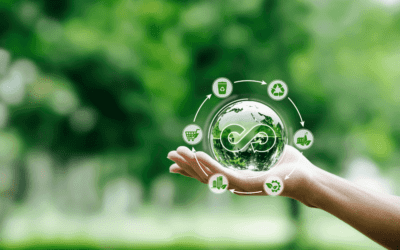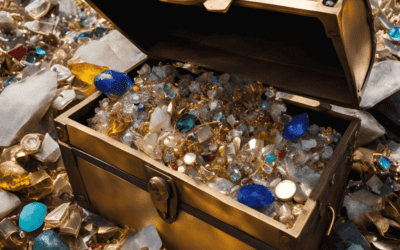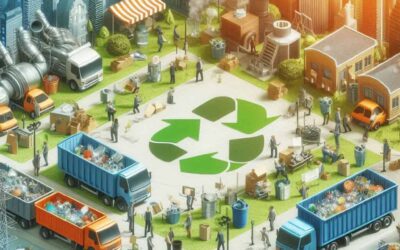When is waste, not waste? When it can be reused, recycled or reclaimed for a second, third – or even multiple times.
This is the essence of the circular economy – where materials that often just go to landfill can be collected, processed and reused to prevent new resources being mined or made to sustain a consumer-led society.
It’s becoming ever more important to keep materials within our economies for as long as possible. Natural resources are depleting fast, abandoned waste has a significantly negative effect on the environment and we cannot sustain increased demand for products by maintaining the current way we do things.
But waste is a hard thing to talk about. Psychologically, it doesn’t tick our boxes in the way that electric cars, or solar panels, or carbon capture can. We’re a world of consumers who love shiny new things – and so our attention is naturally focused on the new products that we think can help challenge climate change, reduce greenhouse gas emissions and have a positive impact on the planet’s future.
Waste, by contrast, isn’t sexy. It’s not interesting. It’s not new. But it could play a pivotal role in the overall climate agenda. In fact, we don’t just believe it could; we believe it should.
Reframing the waste conversation
Fundamentally, we need to stop treating things as ‘waste’ and start treating them as useful materials. We need to be clear about how waste is created in the first place, so we can see how to reduce it. And we need to talk about how we can better manage waste so that it becomes part of a cycle – not just always ending up at the bottom of the pile.
Waste comes in all shapes and sizes – and it’s important to note that the new technologies coming online create their own waste through their production processes – and each type of waste requires a different process in order to prepare for reuse. This potential complexity is one of the reasons why waste is often shoved down the climate agenda – it requires considerable thought, strong leadership and a commitment to change. But by changing the way we deal with waste, we could make huge inroads into reducing greenhouse gas emissions.
The waste we need to manage better includes:
Electronics – according to a report by the BBC, 53.6 million tonnes of waste electronics are thrown away every year. And that number is predicted to rise to 74 million tonnes by 2030. As we’ve discussed in previous blogs, there are many valuable metals and materials in those electronics which we can recover and reuse – helping to reduce mining for brand-new materials (which in itself causes a huge amount of waste). These materials include lithium, copper, silver and gold.
Food waste – a huge contributor to greenhouse gas emissions, we need to do all we can to reduce food waste. This is partly about how we source, buy and use food, but it’s also about how we treat food waste. When it goes to landfill, it simply breaks down and releases gasses into the atmosphere – composting or using for energy production is a much better use.
Industrial and manufacturing waste – manufacturing processes produce waste, and while businesses in many countries are tightly regulated in terms of how they treat certain types of waste, there are always improvements to be made. Simple things like improving transport efficiency can reduce emissions, extend the life of vehicles and reduce the loss of materials during transportation. Thinking about the way production processes use water, heat and light, and having a clear plan for recycling or reusing waste materials can make a real difference.
Plastic waste – while you might feel that you are recycling as much plastic as possible, you’re probably still throwing a lot away. And even if you’re doing your bit, it’s likely to be a drop in the global ocean – a 2019 report found that only 9% of plastic waste was actually being recycled. In many places, plastic is landfilled, dumped elsewhere or even burned – releasing toxic gasses into the atmosphere, water courses and soil. And of course, we’re still producing more new plastic than we recycle or reuse.
What could happen if we were better?
There’s no time to waste. Better management starts with design – instead of using brand new materials, how can we design products so that they use recycled materials instead? And as part of the design process, we need to think about lifespan, repair and replacement parts, and how we can recycle the product at the end of its life cycle. How can we put manageable systems in place to encourage good recycling habits – both for private and commercial use?
This needs a step change in the way we do things – and that usually comes through enforced regulations or legislation, because while many people and businesses want to do the ‘right thing’, not everyone will.
And that leads us to the need for political will – the will to see that waste is a critical issue, and one that must be tackled now if we are to stop covering the planet in rubbish, and instead make a positive impact on the way the world works.
At ISB Global we believe in the value of waste. It’s more than a pile of cr*p, it’s a powerful tool in the fight for climate change and a business opportunity waiting to be realised. Our integrated software solution, Waste & Recycling One (WR1), helps businesses uncover that value and realise that opportunity. To find out more, contact our team today or visit our WR1 showcase below.






